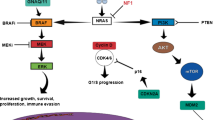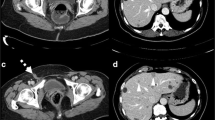Abstract
Purposes
Primary mucosal malignant melanoma (PMMM) is a rare and highly lethal neoplasm associated with a poor prognosis. CXC chemokine receptor 4 (CXCR4) is expressed on various tumor cells, including malignant melanoma. Recent data indicate that CXCL12 and CXCR4 play a critical role in the behavior of cancer cells and in the survival of cancer patients. However, there has been no study that has addressed the expression and function of CXCR4/CXCL12 signaling in PMMM.
Methods
Immunohistochemical staining for CXCL12 and Ki67 in biopsy tissues from 10 cases of PMMM was performed. We analyzed the correlations between the clinicopathological features and expression levels of CXCL12 and Ki67.
Results
Six cases showed a high level of CXCL12 expression, while four cases had a low level of expression. High expression of CXCL12 correlated with a poor prognosis, although statistical significance was not reached (p = 0.054). Ki67 was highly expressed in five cases, while the expression in the other five cases was low. There was no correlation between the Ki67 expression and prognosis.
Conclusions
The findings of this study suggest that CXCL12 expression may play an important role in the biological behavior of PMMM and may be associated with a poor prognosis of PMMM patients.



Similar content being viewed by others
References
Sahoo MR, Gowda MS, Kaladagi RM. Primary amelanotic melanoma of the rectum mimicking adenocarcinoma. Am J Case Rep. 2013;14:280–3.
Chalkiadakis G, Wihlm JM, Morand G, et al. Primary malignant melanoma of the esophagus. Ann Thorac Surg. 1985;39:472–5.
Sabanathan S, Eng J, Pradhan GN. Primary malignant melanoma of the esophagus. Am J Gastroenterol. 1989;84:1475–81.
Machado J, Ministro P, Araujo R, et al. Primary malignant melanoma of the esophagus: a case report. World J Gastroenterol. 2011;17:4734–8.
Iwanuma Y, Tomita N, Amano T, et al. Current status of primary malignant melanoma of the esophagus: clinical features, pathology, management and prognosis. J Gastroenterol. 2012;47:21–8.
Li B, Lei W, Shao K, et al. Characteristics and prognosis of primary malignant melanoma of the esophagus. Melanoma Res. 2007;17:239–42.
Liu Y, Ji R, Li J, et al. Correlation effect of EGFR and CXCR4 and CCR7 chemokine receptors in predicting breast cancer metastasis and prognosis. J Exp Clin Cancer Res. 2010;29:16.
Saur D, Seidler B, Schneider G, et al. CXCR4 expression increases liver and lung metastasis in a mouse model of pancreatic cancer. Gastroenterology. 2005;129:1237–50.
Zlotnik A. Chemokines and cancer. Int J Cancer. 2006;119:2026–9.
Toyozawa S, Kaminaka C, Furukawa F, et al. Chemokine receptor CXCR4 is a novel marker for the progression of cutaneous malignant melanomas. Acta Histochem Cytochem. 2012;45:293–9.
Boni R, Doguoglu A, Burg G, et al. MIB-1 immunoreactivity correlates with metastatic dissemination in primary thick cutaneous melanoma. J Am Acad Dermatol. 1996;35:416–8.
Torres S, Bartolome RA, Mendes M, et al. Proteome profiling of cancer-associated fibroblasts identifies novel proinflammatory signatures and prognostic markers for colorectal cancer. Clin Cancer Res. 2013;19:6006–19.
Samanna V, Wei H, Ego-Osuala D, Chellaiah MA. Alpha-V-dependent outside-in signaling is required for the regulation of CD44 surface expression, MMP-2 secretion, and cell migration by osteopontin in human melanoma cells. Exp Cell Res. 2006;312:2214–30.
Yoshinari C, Mizusawa N, Byers HR, Akasaka T. CD44 variant isoform CD44v10 expression of human melanoma cell lines is upregulated by hyaluronate and correlates with migration. Melanoma Res. 1999;9:223–31.
Dietrich A, Tanczos E, Vanscheidt W, et al. High CD44 surface expression on primary tumours of malignant melanoma correlates with increased metastatic risk and reduced survival. Eur J Cancer. 1997;33:926–30.
Yin M, Soikkeli J, Jahkola T, et al. TGF-beta signaling, activated stromal fibroblasts, and cysteine cathepsins B and L drive the invasive growth of human melanoma cells. Am J Pathol. 2012;181:2202–16.
Kim J, Takeuchi H, Lam ST, et al. Chemokine receptor CXCR4 expression in colorectal cancer patients increases the risk for recurrence and for poor survival. J Clin Oncol. 2005;23:2744–53.
Scala S, Ottaiano A, Ascierto PA, et al. Expression of CXCR4 predicts poor prognosis in patients with malignant melanoma. Clin Cancer Res. 2005;11:1835–41.
Scala S, Giuliano P, Ascierto PA, et al. Human melanoma metastases express functional CXCR4. Clin Cancer Res. 2006;12:2427–33.
Jo (1992) Chemokine receptor CXCR4 expression, function, and clinical implications in gastric cancer. Int J Oncol
Li Z, Li N, Wu M, et al. Expression of miR-126 suppresses migration and invasion of colon cancer cells by targeting CXCR4. Mol Cell Biochem. 2013;381:233–42.
Koshiba T, Hosotani R, Miyamoto Y, et al. Expression of stromal cell-derived factor 1 and CXCR4 ligand receptor system in pancreatic cancer: a possible role for tumor progression. Clin Cancer Res. 2000;6:3530–5.
Gimotty PA, Van Belle P, Elder DE, et al. Biologic and prognostic significance of dermal Ki67 expression, mitoses, and tumorigenicity in thin invasive cutaneous melanoma. J Clin Oncol. 2005;23:8048–56.
Urruticoechea A, Smith IE, Dowsett M. Proliferation marker Ki-67 in early breast cancer. J Clin Oncol. 2005;23:7212–20.
Pich A, Chiusa L, Navone R. Prognostic relevance of cell proliferation in head and neck tumors. Ann Oncol. 2004;15:1319–29.
Jamieson NB, Carter CR, McKay CJ, Oien KA. Tissue biomarkers for prognosis in pancreatic ductal adenocarcinoma: a systematic review and meta-analysis. Clin Cancer Res. 2011;17:3316–31.
Conflict of interest
Daisuke Izumi, Hideo Baba and all other co-authors have no conflicts of interest to declare in association with this study.
Author information
Authors and Affiliations
Corresponding author
Rights and permissions
About this article
Cite this article
Izumi, D., Ishimoto, T., Yoshida, N. et al. A clinicopathological analysis of primary mucosal malignant melanoma. Surg Today 45, 886–891 (2015). https://doi.org/10.1007/s00595-014-1041-y
Received:
Accepted:
Published:
Issue Date:
DOI: https://doi.org/10.1007/s00595-014-1041-y




